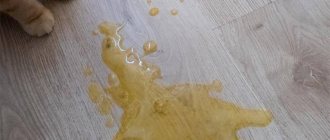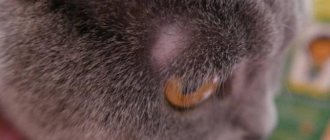Last update: 03/18/2020
A scratch is a violation of the integrity of the surface layer of the skin (epidermis), resulting from contact with a thin sharp object and usually having a linear shape.
The healing time of scratches depends on the depth of the damage and the presence/absence of infection. You can get a similar injury at home, while playing with pets (especially cats), while doing gardening and repair work. To speed up the process of regeneration of a damaged area of skin and protect yourself from pathogenic microbes entering the wound cavity, you need to know how to treat scratches, what healing ointment to use and how to behave if you get a scratch.
How to treat scratches
In order to restore damaged skin as quickly as possible and prevent the possibility of infection, everyone needs to know how to speed up healing and how to treat scratches on the legs, face, arms and other parts of the body.
Treatment begins with correctly provided first aid. The algorithm of actions should be as follows:
- Stop bleeding. To stop the bleeding, press a clean piece of cloth or napkin onto the scratched area for a couple of minutes.
- Cleansing. Since the scratch may have been caused by a dirty or rusty object, the cavity must be cleaned. To do this, wash the wound with a mild soap solution or clean water.
- Disinfection. . To disinfect the damage, hydrogen peroxide, a weak solution of potassium permanganate or furatsilin are used. If you don’t have any of these drugs on hand, you can use plantain. Tear off a leaf, wash it, mash it until the juice comes out, and apply it to the damaged area of the skin.
- A scratch heals quickly if you do not let it get wet. To dry the wound, use iodine or brilliant green. Please note: you only need to treat the edges of the scratch with them, preventing the product from penetrating deep into the cavity (especially if we are talking about deep damage).
You can use ointment or cream to heal abrasions and scratches. It is advisable that the products do not contain hormones and parabens - in this case they can be used not only for adults, but also for children. It is not advisable to cover the scratch with a bandage or stick it with an adhesive plaster, as this may prolong the recovery period. However, if you are going to be gardening or have any other work planned that might get you dirty, you can temporarily cover the wound with a bandage.
If the scratch is on your face and causes you psychological discomfort, you should not camouflage it with foundation or makeup base. The only product that can be used in this case is powder with a drying effect.
If a child has scratches, they should be treated in the same way as in the case of adults. The main thing is not to let your baby pick off the crusts that form when it dries, as otherwise you can introduce an infection into the wound.
Prevention of bites
Healthy indoor cats usually control the strength of their warning or playful bites. A deep wound from a pet can be obtained in the following cases:
- the cat was angry or hurt;
- the cat was fighting with another animal, and the owner tried to separate them;
- she was offended by something and decided to take revenge on the owner (this is typical of exotic breeds, such as Siamese cats);
- the cat was frightened, for example, by the noise of a vacuum cleaner or water;
- leg bites can occur because the cat is “hunting” or playing (this is typical for young animals); If a person's skin is thin and sensitive, the bite may be painful.
It must be remembered that cats are independent animals that have their own boundaries. Unlike dogs, they do not obey their owner one hundred percent and can show character, so in order to avoid bites, you should not tease the cat or try to play with it when it is not inclined to do so. This is especially true for Siamese cats or those with an admixture of Siamese blood. The author of the article lived with a Thai-Siamese cat for many years, which regularly made quite strong bites, not only on the hands, but also on the face, neck, and legs of the owner. The reason for this could be fear from loud noises, resentment (for example, when the owner was absent for many days) or a bad mood of the pet, which, with the help of bites, tried to protect itself from the advances of a person and show that it was not in the mood to play.
Siamese beauties are often biters
Young children who are in contact with the cat should be closely supervised. By trying to play or cuddle the furry cat, they may unintentionally cause pain to the cat, to which the cat may react with deep bites and scratches.
Based on the above, bite prevention involves proper behavior with your pet, which must correspond to the situation, breed and temperament of the cat. Your cat should also be vaccinated against rabies. This must be done if you plan to take it to nature, if the pet walks on the street or comes into contact with other animals that can carry the disease.
The above is also relevant in order to reduce the risk of deep scratches. If the nails are too long, the cat may cause deep damage to the skin by accident. That's why your pet needs a scratching post. You can also have your nails trimmed by your veterinarian; You can do this yourself, but the procedure is responsible, so it is advisable to learn from an experienced person.
Cat scratches: how to treat them and how are they different from other types of scratches?
Harmless games with your pet can lead to disastrous consequences. The cat's body contains the bacterium Bartonella: it does not cause illness in the host animal, but can cause the so-called cat scratch fever (felinosis), an acute infectious disease in humans. Infection occurs through cat bites or scratches. Through damaged skin, the bacterium enters nearby tissues, which can lead to inflammation of the lymph nodes.
How to treat scratches on the skin received from a cat in order to protect yourself from possible felinosis? To do this, it is recommended to treat the damage as quickly as possible using the above method. If you notice that a papule has formed at the site of the scratch, and also notice enlarged lymph nodes, weakness and fever, contact a medical facility immediately.
Can a vaccinated cat get rabies?
The rabies vaccine does not completely guarantee that the animal will not get sick. If during vaccination the cat was infected with worms, then there remains a risk that the vaccination will not give results.
Symptoms of the disease appear within 2 weeks. The presence of the rabies virus in the body during vaccination is the cause of the disease.
Factors that influence the formation of immunity to the virus:
- age of the cat;
- exhaustion;
- stress;
- chronic diseases;
- multiple births.
Fast healing of scratches using traditional medicine recipes
Not only traditional medicine can cope with scratches and other minor skin injuries. Traditional recipes have also proven to be effective in helping to quickly heal scratches on the face, hands and other parts of the body.
What traditional medicine can be used to accelerate the regeneration of damaged epidermis?
- Tea tree oil has disinfecting and drying properties, so it is recommended to use it in the first stage of skin restoration after a scratch.
- How to not only speed up the healing of scratches on the face, but also improve the overall condition of the skin? To do this, use castor and sea buckthorn oils. They are widely used in cosmetology due to their regenerating properties. Rub them over damaged skin to get rid of scratches as quickly as possible.
- Aloe juice deservedly enjoys the fame of a home doctor. Cut off the old fleshy leaf of this houseplant, wash, cut off the skin and grind in a blender. Squeeze the resulting pulp through cheesecloth to obtain juice. Rub it over the scratch until it heals.
- Buckthorn (oak bark) has astringent, disinfectant, and anti-inflammatory properties. Prepare a decoction of buckthorn and wipe the scratch with a cotton pad soaked in it.
- Beetroot juice can be used to treat minor skin lesions. Grate the beets or grind them in a blender, then squeeze the resulting pulp through cheesecloth. It is useful to make compresses from beet juice or simply wipe scratched areas.
Atypical forms
In some cases, the disease is particularly severe, which is called the atypical form. If Bartonella does not enter through the skin (for example, the mucous membrane of the eye), then the disease proceeds differently and can develop:
- Parito's conjunctivitis - when one of the eyes becomes red and swollen. There are difficulties opening the eyelid. The person does not experience pain, but when examining the conjunctiva, the specialist will notice ulcers on it. At the same time, the anterior auricular lymph nodes enlarge, which can fester and open up on their own after a while. The person becomes lethargic, the temperature may rise and insomnia may appear.
- Neuroretinitis is when one of the eyes begins to see worse. The general condition does not change.
If a person has a weakened immune defense, then the microbe multiplies very actively and can affect the nervous system and enter the internal organs. Those at risk include people living with HIV, people with diabetes and people who abuse alcohol.
- If the nervous system is damaged, numbness in the fingertips may occur. In the worst situation, the motor function of one limb or several at once is impaired, tremors and a lack of coordination appear. In some cases, convulsions, disturbances of consciousness and paralysis of the facial nerve are possible.
- When the microbe enters the internal organs, various problems are possible in the form of: myocarditis, splenic abscess, arthritis, pleurisy, atypical pneumonia and osteomyelitis.
Cream "La-Cri" for sensitive skin - an effective assistant in healing scratches
The La-Cri cream contains components such as walnut, string and violet extracts, avocado oil, panthenol and bisabolol. These ingredients have a regenerating, anti-inflammatory and antimicrobial effect, due to which scratches and abrasions quickly heal without the formation of scars and scars.
La-Cri products are made without the use of hormones, parabens and fragrances, so their use is allowed even for small children, pregnant women and allergy sufferers with sensitive skin.
Complications
When Bartonella, which causes felinosis, spreads through the blood to various internal organs, the following may occur:
- pleurisy;
- myocarditis;
- spleen abscess;
- osteomyelitis;
- arthritis;
- atypical pneumonia.
The bacterium can also cause significant blood complications, consisting of a decrease in various blood cells:
- platelets (thrombitopenic purpura);
- red blood cells (hemolytic anemia);
- eosinophilic leukocytes (eosinophilia);
- leukocytes (leukoclastic vasculitis).
Clinical researches
A clinical study conducted by the company together with the Union of Pediatricians of Russia proves the high efficiency, safety and tolerability of products for daily skin care of children with mild and moderate forms of atopic dermatitis and during remission, accompanied by a decrease in the quality of life of patients. As a result of therapy, a decrease in the activity of the inflammatory process, a decrease in dryness, itching and flaking was noted.
It has been proven that La Cree cream for sensitive skin reduces itching and irritation, relieves redness of the skin, moisturizes and gently cares for it. The product is recommended by the Union of Pediatricians of Russia.
Treatment of the disease
Felinosis is treated as follows: medications are prescribed for systemic use, compresses, and surgical treatment can be used.
Typical uncomplicated lesions of the heart, liver, spleen, and nervous system can be treated at home. Other forms require hospitalization of the person.
Drug treatment
Appointed:
- Antibiotics: doxycycline, erythromycin, tetracycline, ofloxacin, gentamicin, clarithromycin. They are used in the form of tablets, and in case of eye damage, also in the form of eye drops.
- Anti-inflammatory and painkillers: ibuprofen, diclofenac, mefenamic acid.
- Antihistamines: cetrin, L-cet, zodak, erius and others.
- In severe cases, glucocorticoids may be prescribed: dexamethasone, prednisolone.
Compresses
It is recommended to apply compresses to the area of inflamed lymph nodes. Take 1 part dimethyl sulfoxide to 4 parts water, wet gauze with this mixture, apply it to the lymph node, put polyethylene on top, and then secure it with a bandage and insulate it with a warm cloth.
Physiotherapeutic methods
The area of inflamed lymph nodes is exposed to UHF and diathermy.
Surgery
If the affected lymph nodes are tense and painful, they are punctured for the purpose of drainage: this way the pressure in the node decreases, which helps in relieving the pain process.
Consumer Reviews
Ulya15 (irecommend.ru)
Cream find for dehydrated and dry skin!
I have moody skin with rashes on my forehead. And in the autumn-winter period, when it is cold, windy and the heating is turned on, it looks like a wrinkled apple. And this cream is just a godsend!
Here are the benefits that I have identified for myself:
- Beautiful design and comfortable tube, there was protective foil on the neck
- The texture of the cream is thick, airy, and spreads well over the skin.
- Delicate herbal scent, I immediately associate it with summer
- Large tube volume, the cream will last for a long time, because in order to apply the cream to the body you only need a drop
- Relieves allergic itching and itching from insect bites
- Copes perfectly with flaking, leaving the skin soft and moisturized
- Evens out the complexion, the skin becomes matte and does not become oily
- Quickly absorbed
- Can be used from the first days of life
I recommend!
Verno (irecommend.ru)
“I am the happy owner of a whole arsenal of a wide variety of creams. And it always seemed to me that I had a cream for any occasion, for any part of the body. But all my confidence disappeared when a child appeared in the house. It turned out that my entire arsenal could not be used to save the baby’s skin. This is how La Cree cream appeared in the house. Of course, it appeared not only because of the child, but thanks to him.
A 30 ml tube of cream costs about 200 rubles. A little expensive, but worth it! The cream is practically odorless, absorbs well, leaving no film on the skin. True, the color of this cream is very unattractive...
Now about the properties.
The cream relieves redness, eliminates irritation and moisturizes the skin. I love that it absorbs quickly and leaves my skin feeling smooth instantly.
The cream saved my husband from skin irritation after shaving.
The cream helped the child when his cheeks turned red. If someone had not rubbed their cheeks on the sheet, they would not have blushed, but then I would not have known how wonderfully and quickly La Cree helps.
I use this cream for irritation of the skin of my hands, which occurs after prolonged contact with water.
In general, I am more than satisfied with the La-Cri cream. And now he is always in the house, where he has noticeably replaced all my creams.”
Gen_ asya ( irecommend.ru )
“Salvation in a tube. Initially, the cream was purchased for a small child in order to relieve skin irritation. I was attracted by the price, natural composition and good reviews about the cream. The cream coped with the task perfectly.
Later I tried it against mosquito bites - the irritation decreased, the redness subsided a little, and it also helps a lot with various allergic redness on the skin.
The tube itself is quite informative and has a pleasant green color scheme. The composition and recommended use are indicated on the back; the tube contains 30 grams of product.
The consistency of the cream is quite thick, it applies well and is quickly absorbed, leaving no traces of the cream, the skin becomes quite pleasant to the touch, but the smell is not for everyone, I personally didn’t really like it, it’s distinctly grassy.
The manufacturer states that the cream can be used in winter, protecting against cold environmental influences, and also saves from excessive dry skin.
The consumption of the cream is quite economical, a tube lasts me more than half a year, at a price of about 200 rubles, this is obviously a good buy.
I recommend the cream both for children and other family members; it will delight you with its composition and effect.”
Sources:
- Chapman M. Shane, Habiff Thomas P., Zug Catherine A., Dinoulos James G. H., Campbell James L., Dermatology. Handbook of differential diagnosis, publishing house: MEDpress-inform, 2014
- Mancini Antoni G., Krouchuk Daniel P., Pediatric dermatology. Directory, publishing house: Practical Medicine, 2018
- Pankratov Valentin Gavrilovich, Pankratov Oleg Valentinovich, Infectious dermatology in the practice of primary care physicians, New Knowledge Publishing House, 2015
Signs of rabies in humans
The very first symptom of the disease is inflammation of the bite site. Swelling and redness appear, which increases in size.
The disease appears faster in children than in adults
The skin color becomes dark red. The itching increases, the person feels pain that was not there before. Fatigue, heaviness in the head, weakness indicate that the virus has entered the body.
Often the disease is accompanied by additional symptoms:
- body temperature 37.5 degrees or more;
- nervousness;
- nausea, vomiting;
- painful sensitivity to light;
- avoiding harsh sounds;
- worsening sleep;
- anxiety;
- apathy.
The primary signs of infection are nonspecific; similar symptoms accompany other viral diseases. If you have been bitten by an animal before, you should immediately consult a therapist.
Features of the lush form
In the violent form, a person becomes aggressive and tries to hurt himself or others. Auditory hallucinations occur.
During the examination, the doctor notes the following signs in the patient:
- increased breathing and heart rate;
- difficulty swallowing;
- fear of water;
- attacks of fear in bright light, open space;
- convulsive attacks.
Paralytic form
The paralytic form lasts 2-3 days and is identified by symptoms:
- drooling due to muscle paralysis;
- weakness in the arms: the person is unable to lift objects;
- slack jaw;
- increased body temperature;
- during an attack the person cannot breathe;
- anxiety gives way to apathy.
The entire period of the disease reaches 10 days without an incubation period. The paralytic form always ends in the death of the patient.











